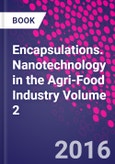Encapsulations, a volume in the Nanotechnology in the Agri-Food Industry series,presents key elements in establishing food quality through the improvement of food flavor and aroma. The major benefits of nanoencapsulation for food ingredients include improvement in bioavailability of flavor and aroma ingredients, improvement in solubility of poor water-soluble ingredients, higher ingredient retention during production process, higher activity levels of encapsulated ingredients, improved shelf life, and controlled release of flavor and aroma. This volume discusses main nanoencapsulation processes such as spray drying, melt injection, extrusion, coacervation, and emulsification. The materials used in nanoencapsulation include lipids, proteins, carbohydrates, cellulose, gums, and food grade polymers. Applications and benefits of nanoencapsulation such as controlled release, protections, and taste masking will be explained in detail.
Please Note: This is an On Demand product, delivery may take up to 11 working days after payment has been received.
Table of Contents
Chapter 1. Exploring nanoencapsulation of aroma and flavours as a new frontier in food technologyChapter 2. Micro and nanoencapsulation in foods: An assured technique to protect the flavors and aromas
Chapter 3. Food encapsulation: A nanotechnology approach
Chapter 4. Nanoencapsulation of flavors and aromas by cyclodextrins
Chapter 5. Electrohydrodynamic microencapsulation technology
Chapter 6. Cyclodextrins as nanoencapsulation material for flavors and aromas
Chapter 7. Structural and thermodynamic insight into the potentiality of food biopolymers to behave as smart nanovehicles for essential polyunsaturated lipids.
Chapter 8. The utility of nanotechnology for encapsulation of Vitamins C and E: Food shelf-life improvement
Chapter 9. Nanocomposite packaging for food encapsulation
Chapter 10. Microencapsulated bioactive components as a source of health
Chapter 11. Nanoencapsulation technology to control release and enhance bioactivity of essential oils
Chapter 12. Encapsulation: Entrapping essential oil/flavours/aromas in food
Chapter 13. Cyclodextrins-based nanocomplexes for encapsulation of bioactive compounds in food, cosmetics, and pharmaceutical products
Chapter 14. Nanoencapsulation of essential oils for sustained release: Application as therapeutics and antimicrobials
Chapter 15. Nanoencapsulation and nanocontainer-based delivery systems for drugs, flavours, and aromas
Chapter 16. Nanoencapsulation of natural antimicrobial products
Chapter 17. Supramolecular strategy for the encapsulation of low molecular weight food ingredients
Chapter 18. Biocompatible microemulsions for the nanoencapsulation of essential oils and nutraceuticals
Chapter 19. Nanoencapsulation of flavours: Advantages and challenges
Chapter 20. Use of spray-drying process in the food industry: Applications on nanomaterials








